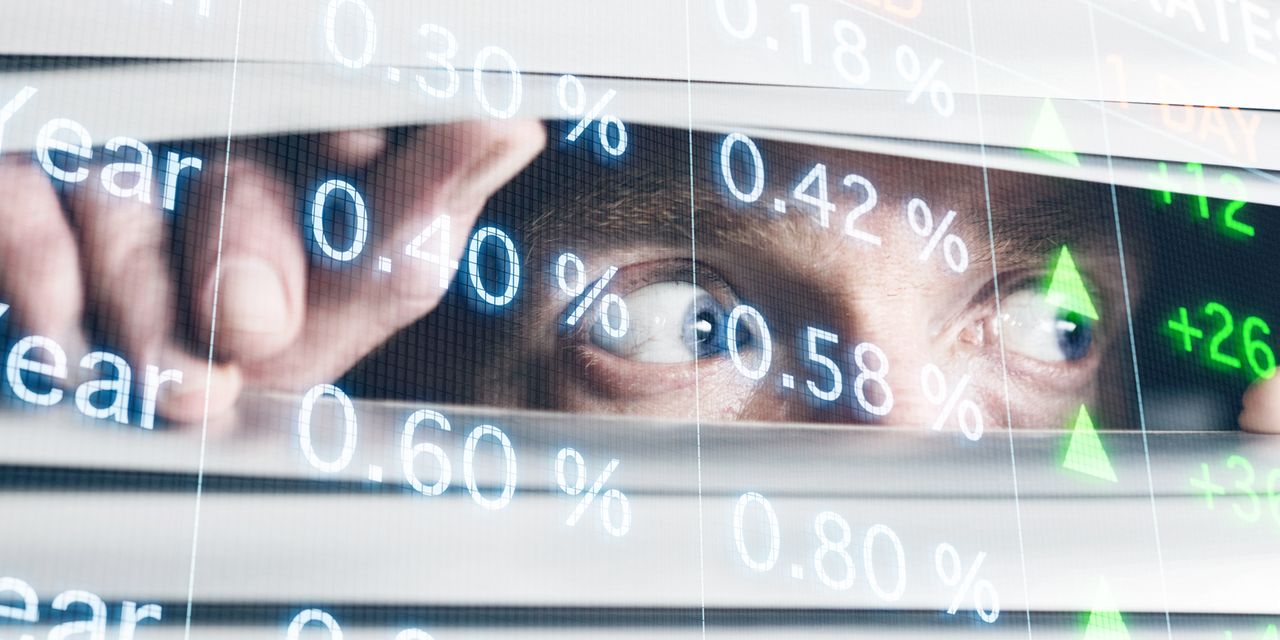The consequences of higher interest rates are still unfolding. For savers, the news has been good because you can get a 5% yield with little risk at the bank. For borrowers, times are difficult because loan rates have shot up, but also because people with federal student loans must resume making payments in October, as the COVID-19 pandemic moratorium expires.
Bond investors’ expectation of a recession explains why 10-year U.S. Treasury notes
BX:TMUBMUSD10Y
are yielding about 4.5%, while three-month Treasury bills
BX:TMUBMUSD03M
are yielding 5.48%. Signs of a significant slowing of the economy would presumably lead to a cut in interest rates by the Federal Reserve and lift bonds’ market prices.
But some investors expect long-term rates to rise significantly from here — the type of move that can put pressure on stocks, as we saw in 2022 when the S&P 500
SPX
fell 18.1% and the benchmark index’s information technology sector dropped 28.1%. So far this year, the S&P 500 has returned 14.1%, while the technology sector has risen 34%. (All these figures include reinvested dividends).
Every day that the stock market is open, the Need to Know column features a “call of the day.” In Tuesday’s column, Barbara Kollmeyer reported on what two veteran money managers at different firms agree — the need for investors to load up on these “neglected” asset classes as protection against much higher long-term interest rates.
Neglected asset classes:
- JPMorgan says the coming energy crisis may be worse than what Europe experienced
- Uranium prices are still ‘nowhere near the peak of the last cycle’: Here’s why nuclear energy ETFs could power your portfolio
The Fed’s “golden handcuffs” for housing and a possible policy mistake
With a national average interest rate of 7.19% for a 30-year mortgage loan as of Thursday, according to Freddie Mac’s Primary Mortgage Market Survey, it is no surprise that many homeowners are fettered by “golden handcuffs.” Millions of borrowers have low-interest-rate mortgage loans locked in and they are reluctant to move and take out new loans with interest rates that might be twice as high as those on their current loans.
This has helped lead to a continuing increase in U.S. home prices, because of a lack of supply. Those price increases drive up overall inflation, which is the opposite of what the Federal Reserve is trying to achieve through its interest rate increases, as David Piscatelli of Avenue One explains.
This weighting of the Fed’s inflation measures to shelter costs “makes no sense whatsoever, and it’s totally disconnected from market conditions,” according to Campbell Harvey, a finance professor at Duke University.
During an interview with MarketWatch Editor-in-Chief Mark DeCambre, Harvey made the case for what the Fed had already achieved and said the central bank’s course from here will determine how severe a coming recession will be.
More about the Fed and interest rates:
A different take on interest rates — for savers
While stock-market investors face a risk that an increase in long-term interest rates could hurt them, savers face a different risk. If there were signs of a recession in the U.S., the Federal Reserve would lower interest rates. Savers who have locked-in rates of 5% or higher with bank CDs may be looking at a different set of risk/reward factors when those CDs mature.
This week the Federal Reserve left the federal funds rate unchanged in its target range of 5.25% to 5.50%. The Fed’s economic projections signal one more possible increase of a quarter point, as well as the possibility of a change in direction next year.
Andrew Keshner speaks with economists who believe we may be near peak bank interest rates for this economic cycle, and he shares advice on how to ladder savings deposits now. The banks would be expected to lower their deposit rates quickly if they were convinced the Fed was finished raising rates.
IPOs go boom, but can also fall to earth
The IPO Report rounds up recent initial public offerings of stock.
This week, Instacart, which is incorporated under the name Maplebear Inc.
CART,
priced its IPO at $30. The shares jumped during initial trading to move as high as $42.95 on Tuesday, but then traded as low as $29.90 on Thursday, before ending that day at $30.21.
Therese Poletti looks into varying opinions of Instacart’s valuation and has a warning for investors about the IPO market.
Shares of Klaviyo
KVYO,
began trading on Wednesday, also with an IPO price of $30. Bill Peters shares five things to know about the digital marketer. Kvyo’s shares followed a pattern similar to that of Instacart, rising as high as $39.47 Wednesday, before closing at $32.76. The stock rose to $33.72 Thursday.
Another IPO that sank quickly following initial euphoria was Arm Holdings PLC
ARM,
The company’s American depositary receipts were priced at $51 and traded as high as $66.28 after trading began on Sept. 14. They closed at $52.16 on Thursday after falling as low as $49.85.
Ciara Linnane summed up the pattern of recent IPOs losing their shine.
Palantir’s CEO takes on the skeptics
Shares of Palantir Technologies Inc. have risen 118% this year. But if you look at the price chart above, which begins on Sept. 30, 2020 when the stock was directly listed on the New York Stock Exchange, it is easy to understand why some investors would remain skeptical.
Emily Barry interviewed Palantir CEO Alex Karp, who said that despite the hype associated with the rollout of artificial intelligence technology, his company is one of the few that has been delivering on its promises.
Good times may come soon for Micron
On Sept. 17, Deutsche Bank analyst Sidney Ho upgraded Micron Technology Inc.
MU,
to a buy rating, making the case in a note to clients that the company’s inventory and pricing challenges for its legacy computer memory products were subsiding and that prices were increasing for high bandwidth memory chips.
Here’s a deep dive into Micron’s prospects as it prepares to roll out the next generation of HBM3 chips for use with Nvidia Corp’s
NVDA,
graphics processing units, which have driven the latter company’s rapid sales growth this year and have led to a near tripling of its stock price.
More tech: Here’s why Cisco may want to close the Splunk deal sooner rather than later
An industry change tied to inflation and changing behavior
American consumers have fallen out of love with cereal. One result of this is the decision by Kellogg’s Co. to spin out its cereal business business into a separate company. General Mills Inc.
GIS,
has cited inflation when lowering its sales guidance.
But inflation isn’t the only factor affecting cereal sales. Zoe Han reports on how consumers’ behavior and tastes are changing as they start the day.
A good stock-market marriage
Michael Brush shares comments from Elise Hoffmann and Chris Niemczewski, who are married and manage the Marshfield Concentrated Opportunity Fund MRFOX, which is rated five stars (the highest rating) within Morningstar’s “Large Growth” fund category. Here are five approaches they have taken to beat the stock market’s performance.
Tips on how to avoid taking a job that you might not like
Here are 5 questions to ask a prospective employer before you are hired.
A big change is coming for Amazon Prime Video
Amazon.com Inc.
AMZN,
announced that Prime Video viewers will see commercials starting in January unless they pay a monthly fee to escape the ads while helping Amazon to create “compelling content.”
More video streaming and related news:
Want more from MarketWatch? Sign up for this and other newsletters to get the latest news and advice on personal finance and investing.
Read the full article here





